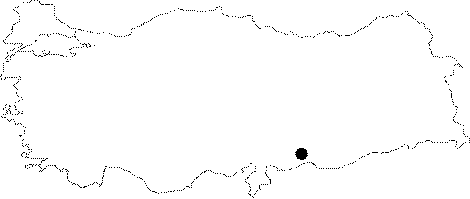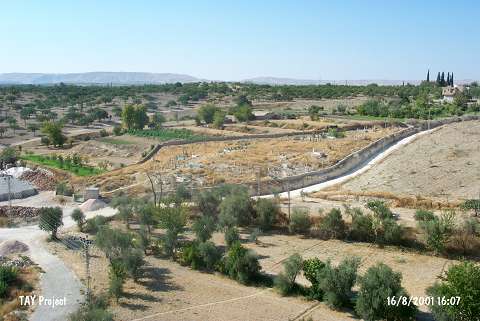|
©The Archaeological Settlements of Turkey - TAY Project
|
|
|
|
|
|
Hacinebi Mezarligi |
|
|
For site maps and drawings please click on the picture...  |
For photographs please click on the photo...  |
|
Type:
|
Mound |
|
Altitude:
|
490 m |
|
Region:
|
Southeastern Anatolia |
|
Province:
|
Sanliurfa |
|
District:
|
Birecik |
|
Village:
|
Ugurcuk |
|
Investigation Method:
|
Excavation |
|
Period:
|
EBA I |
|
|
|
 |
|
| Location: It is located next to Ugurcuk (Hacinebi) Village; 5 km north of the Birecik District; northwest of the Sanliurfa Province. |
| Geography and Environment: It is located in a very suitable place; that can be crossed by walk or a small boat; on the eastern bank of the Euphrates; besides being on the river's trade route in the north-south direction (For details; see Harmankaya et al. 1998:Hacinebi). |
| History: |
| Research and Excavation: It was excavated under G.J. Stein of Northwestern University in 1992-1997. The EBA cemetery was revealed in the 1996 excavation at the trench Op.18 on the slope; area A on the northeast of the mound; and at trench Op.12; area B on the southeast. Both cemeteries are proposed to be contemporary. However; to verify this interpretation; no transitional trenchs were opened. The burial traditions were not thoroughly comprehended due to the restriction of the excavated areas. |
| Stratigraphy: The mound of Hacinebi houses the following settlements from top to bottom; Roman Period (1st century AD) farm settlement Hellenistic Period EBA I Cemetery (3.100-2.800/2.700? BC) Late Chalcolithic Age Phase B2 (3.700-3.200 BC) Late Chalcolithic Age Phase B1 (3.800-3.700 BC) Late Chalcolithic Age Phase A (4.000-3.800 BC) |
| Small Finds: Architecture: The architectural remains of the EBA settlement unrelated with the northeastern and southeastern cemeteries were revealed in trench Op.12. Two building levels were identified [Stein 1997:117]. The sherds dating from the Late Chalcolithic Age are suggested to be second-use or come from the embankment earth. The settlement of Hacinebi cemetery is assumed to be located beneath Ugurcuk Village nearby on the south of Hacinebi instead of the excavated area. Human Remains: It is suggested that the site had been occupied as a cemetery by a community resided far from the hill at least for 100-200 years after the settlement of Late Chalcolithic Age was destroyed and abandoned. Similar to other EBA cemeteries in the vicinity; there are three types of graves. Trench Op.18 yielded 4 cist graves [Stein 1997:fig.18]. All graves lie in the northeast-southwest direction. They are small rectangular structures built by standing flat stones. They are also capped with flat stones and covered by the help of loam mortar. As no child skeletons were found in this section; the cemetery was; probably; built for adult burials only [Stein 1997:115]. The cemetery plan exposes that almost all of the graves are contemporary and the place of the graves are marked by an object like a stone or wood following the burial. Three of the graves were disturbed before they were brought to light as they were very near the surface. Only grave no. 5 provided some evidence about the burial traditions. Trench Op. 12 yielded three types of graves such as pithos grave; simple pit burial and cist grave housing both adult and children burials. The pithos graves were capped by a bowl after the children were buried into the pithoi. It is noted that those pithoi were not produced for burial purposes only; but employed as cooking or storage jars in the daily life. Their sizes vary; i.e. they don't have a standard size. One of them is the mottle washed ware in dark reddish gray. Another one has a rim diameter of 19-21 cm. One of the simple pit burials (No.128) yielded a contracted; and the other (No. 141) stretched out skeletons. Both skeletons belong to an adult. Two cist graves built of mudbrick and stone walls (No. 145 and 153) were uncovered in this area [Stein et al.1997:117). One of them (No. 153) has two stone walls and one mudbrick wall. The fourth wall was not identified as it remained inside the trench wall. The grave was capped by two big plate stones. The skeleton was interred nearly in the northwest-southeast direction. Grave Goods: Among the cist graves of trench Op.18; only grave no.5 yielded rich grave goods because it was not plundered yet. 17 pieces of pottery recovered are amazing. Footed bowls with a bulging body; vessels with belly and long-neck; long footed fruit stands called goblet were found [Stein et al. 1997:fig.9; 20]. Also found are various types of copper/bronze pins; a silver ring; probably; used as earring. An unfooted vessel with a bulging body and long neck bears reserved slip decoration and diagonal lines. Some sherds have evidence of red paint. The pinkish white wash of a footed squat vessel was not applied by reserved slip method or cleaned after applied so that the red color of the ware was used as a decoration where required [Stein et al. 1997:fig.20c]. The pastes of all vessels are grit and plant tempered. Plenty of beads recovered from the same grave; probably; belongs to a long string of necklace. Beads in frit; copper/bronze pins and small vessels were left as grave goods into one of the pithos graves uncovered at trench Op.12. One of the simple pit burials (No. 141) housed bones; probably; belonging to a donkey. Such a find and position of the burial couldn't be clarified. Only one of the graves built of mudbrick and stones (No.153) yielded a bowl with a bulging lip and a broken fruit-stand. The other one was robbed during the same era. Only a skeleton was recovered from this grave. |
| Remains: |
| Interpretation and Dating: The earth accumulated by the EBA I cemeteries and the deposits of upper layers locked the remains of the Late Chalcolithic Age-EBA I settlement. The excavation team analyzed all the finds in detail and published those [Stein et al. 1997:129-132]. The cemeteries of both areas were dated on the basis of the graves and the grave goods. Likes of the vessels both used as graves and left into the graves were examined. As a result; likes of those vessels were found at VIB2 level of Arslantepe dated from the EBA I; Hassek Höyük and level V of Kurban Höyük according to their characteristics of ware and forms [Stein et al. 1997:130]. One of the elements contributed to the dating of the cemeteries is a Nineveh V type vessel recovered from one of the graves. Results of 14C samples were not provided. The cemetery of Hacinebi played an important role in the dating of the cemetery of Birecik Baraji yielding similar finds. |